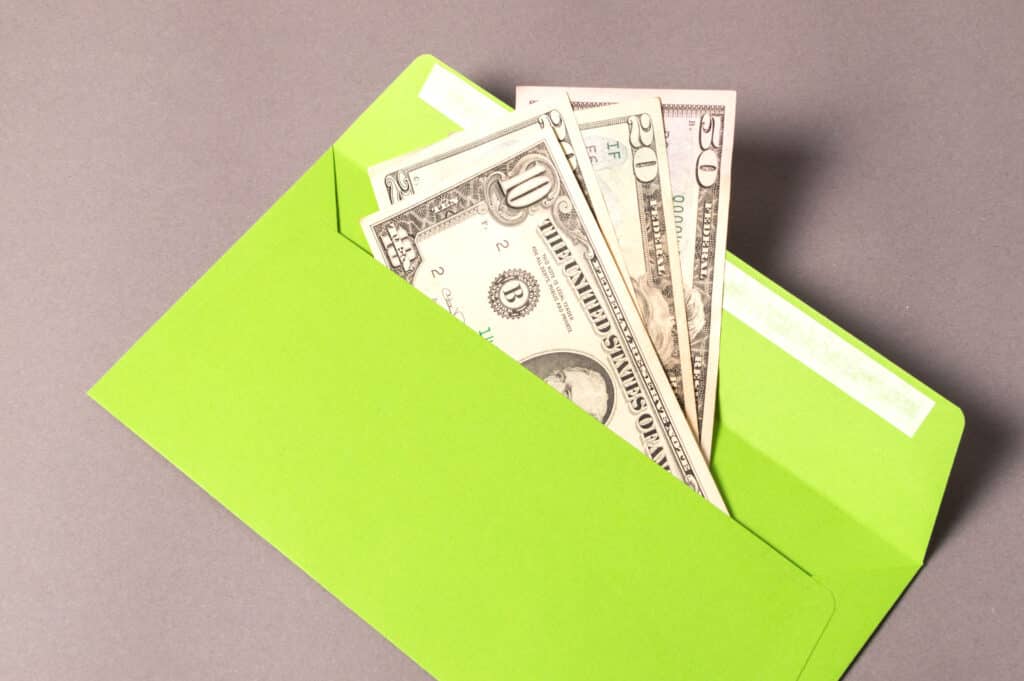Who Knew Stuffing Envelopes With Cash Could Be So Fun?
Download Free Envelope Budgeting Printable
The envelope budgeting system can be a simple and useful method to create a simple and practical household budget. Here’s how you can get started.
“There’s no school like old school.”
“Classics never go out of style.”
“If it ain’t broke, don’t fix it.”
Whatever the expression, the sentiment appropriately describes how we feel about the cash-and-envelope system for managing our household expenses. This method is a virtually foolproof way to live within our means (or even better, below our means), avoid credit card debt, and kick-start our savings goals.
There are some long-term drawbacks and shortcomings to this approach for managing our cash flow, but this is likely the best option out there for those who need a serious check to overspend and continually spiral into debt. If you’ve struggled with any of the following financial setbacks within the past year, please take that as a sign that you should switch, at least for now, to the cash-envelope system:
-
You overdraft on a checking account or bounce a check or two, or more.
-
You carry a balance on at least one credit card from month to month and pay interest on the account.
-
You have no savings to speak of.
-
You need to work overtime or get a second job to cover basic living expenses.
-
You spend money on trivial stuff before priorities are met.
-
You take out a cash advance on a credit card.
-
You have used a payday loan, title loan, rent-to-own, pawn loan, or tax refund anticipation loan.
The power underlying the cash envelope system is twofold:
First, it’s simple. Put a predetermined amount of cash into an envelope for each monthly household expense and use that cash throughout the month (e.g., $600 in a “Groceries” envelope, $100 in an “Entertainment” envelope, a “Christmas Gifts” envelope, etc.)
Second, you can’t overspend. Once the cash from the envelope is gone, it’s gone.
That’s it!
Of course, there are a few other keys to making this work. First, commit yourself and, if you have a partner, to stick to the system. You must also take your debit and credit cards out of your wallet and leave your checkbook at home.
Keep in mind that as you proceed with the envelope system, it does not need to be a permanent program. Once you regain control of spending and establish a habit of short-term savings and planning, it will eventually make more sense to move from the envelope system to savings accounts. There’s nothing stopping you from opening up multiple savings accounts, one for each monthly expense and short-term savings goal that you once used envelopes for.
On the other hand, if you begin to feel that your finances are starting to head back down the road to chaos (a.k.a. overspending, no savings, credit card balances, etc.), you can always move immediately back onto the envelope system. Like an old friend, it will be there to get you through the tough times.
Step-by-Step to Stuffing Envelopes
Each household’s envelope system may, and probably will look different. We can choose to use actual postal envelopes or we can use separate boxes and piggy banks. Some will have plain, handwritten labels while others may be colorful and clever enough to be eye-catching. Regardless, below are a few steps that every system needs. Remember that our envelope system should not include expenses that we can automate through the merchant or through our financial institution’s bill pay service.
-
Identify and make a list of monthly household spending categories that cannot be set up on an automatic payment plan. (Groceries, entertainment, fun money, dining out, gasoline, gift giving, vacation, recreation, etc…)
-
Choose an envelope-like receptacle where you can store cash and coins for each spending category you’ve identified in step one.
-
Determine how many bills in each denomination you’ll need for each of the categories in step one and for all categories put together. You’ll want to know this for step four.
-
The day you get paid, withdraw cash from your financial institution account in the amounts and denominations identified in step three.
-
Use only the cash from your envelopes for household expenses. Take your debit and credit cards out of your wallet and purse so you’re not tempted to use them. If necessary, shred them.
A Point to Consider: The “Denomination Effect”
The “Denomination Effect” refers to a phenomenon of consumer behavior studied by Priya Rhagubir and Mary Jacoby Fellow that says, in essence, that the larger the denomination of bill you have to spend, the less likely you are to spend it on small purchases. Translation? Don’t carry lots of $1 dollar bills. You’re hesitant to break a $50 bill, particularly for a small, unnecessary purchase.
Recap of How the Envelope Budgeting System Works
Many individuals and couples find budgets difficult to create and even more difficult to follow. After all, budgets are just numbers and math, right? Well, no. Budgets have to involve priorities and plans. However, many people associate budgeting with restrictions, preventing most households from even getting started.
This explains why an envelope budgeting system can be such an effective tool in establishing household financial order out of chaos and reigning in uncontrolled spending.
Surprising Simple Details that make the envelope system work
The envelope system is beautiful in its simplicity. Here are the only two steps involved:
-
For each general type of potential monthly expenditure, be it a bill, a purchase, or a savings deposit, identify an amount of money needed for the month
-
Add that amount of cash into a labeled envelope to be used only for the intended purpose
Envelope Budgeting Systems have their advantages and their own set of challenges, but they are particularly beneficial tools for households prone to overspending.
Advantages of the Envelope System:
-
Simplicity: No balancing required. No math or even accessing online bank accounts. When there is money in the envelope, you can spend it. When there is no money in the envelope, you do without or otherwise get creative, but it’s gone.
-
Visual and Kinetic: You have no doubt heard that most people are “visual learners.” The truth is much more complicated, but it is true that most people learn better when they “see” the problem and the solution (visual). You also tend to learn and remember when you can have a hands-on experience (kinetic). The envelope system provides both. Seeing money in the envelope, seeing empty envelopes, and seeing money leave the envelope are all-powerful learning experiences. Holding the cash in hand also forces you to recognize the amount of money you are about to spend. You do not get that experience with plastic.
-
Spend Less: Studies show that when using cash rather than plastic (credit, debit, or prepaid cards), the typical American consumer spends nearly 15% less at groceries, department, and clothing stores and over 30% less at restaurants.
-
Avoid Fees: If you only take the specified amount of cash into the store, you won’t go into debt (e.g. credit cards) or face the possibility of over-drafting (e.g. debit cards and checks).
Disadvantages of the Envelope System:
-
Accountability: You must be honest with yourself and, if you are married, honest with your spouse when using the money. Be careful not to steal from one envelope category to cover splurges or uncontrolled spending in another. Have a weekly “huddle” with your spouse to account for each other’s spending.
-
Security: If you go the cash-only route, be careful how you carry it. Losing cash is not like losing a credit card when you can call the bank and have them cancel all future purchases. Once cash is lost, it is generally lost forever. If you place it in a wallet, carry it in your front pocket, not your back pocket.
-
Safety: If you go cash-only, be careful how much you take with you. You never want to draw attention to the fact that you are carrying a lot of cash, for obvious safety reasons.
A full-blown envelope budgeting system may not be for you. If such is the cash, consider some sort of hybrid system. In particular, using cash for fun money, grocery shopping, gasoline, entertainment, dining out and clothes shopping can be very effective.
Whichever method you choose, we hope you take advantage of our free Envelope System labels download.
Instructions:https://<a href=”https://moneyfit.com/wp-content/uploads/2022/05/Envelope-Budgeting-Printable.pdf
-
Download the Money Fit Envelope Budgeting System file in PDF format.
-
Print using a standard label page, size 8½ x 11, 3 columns across, 10 rows down (e.g. Avery template 5160)
-
On each label, note the amount of cash allotted to each category
-
Affix each label to its own envelope
-
After each payday, insert the proper amount of cash into each envelope
-
Take the appropriate envelope with you when making the corresponding purchase or spending on the identified activity
What to Do & Not to Do with the Cash Envelope System
-
Don’t carry a lot of small bills in your purse or wallet.
-
Don’t use the envelope system as a replacement for short-term savings accounts or long-term investment accounts.
-
Don’t give up. It might take three or four months to really get the envelope system working in your household.
-
Do be specific with the envelope labels (i.e. “Trip to Our Favorite Spot on the Coast” rather than just “Vacation”)
-
Do keep your envelopes in a safe place (not the car or where children and/or guests in your home might find them)
-
Do leave debit and credit cards and checkbooks at home when shopping with cash.



